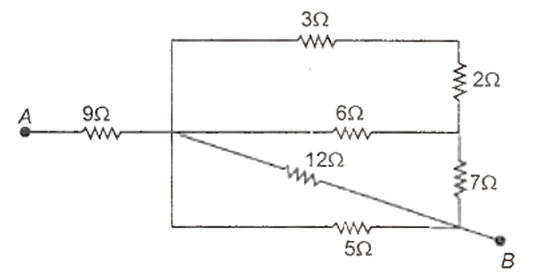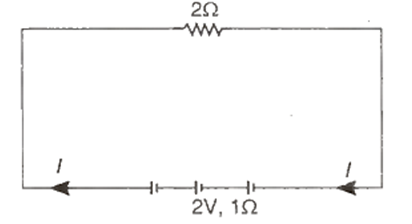 Multiple Choice Questions
Multiple Choice QuestionsA milliammeter of range 0- 30 mA has internal resistance of 20 Ω. The resistance to be connected in series to convert it into a voltmeter of maximum reading 3V is
49 Ω
80 Ω
40 Ω
30 Ω
In the given circuit the equivalent resistance between the points A and B in ohms is

9
11.6
14.5
21.2
In the electric circuit shown each cell has an emf of 2V and internal resistance of 1Ω. The external resistance is 2Ω. The value of the current I is : (in amperes)

2
1.25
0.4
1.2
The radius of the coil of a TG which has 10 turns is 0.1 m. The current required to produce a deflection of 60° (Bh = 4 × 10-5 T) is
3 A
1.1 A
2.1 A
1.5 A
B.
1.1 A
An electric bulb is marked 100 W, 230 V. If the supply voltage drops to 115 V, what is the total energy produced by the bulb in 10 min ?
30 kJ
20 kJ
15 kJ
10 kJ
In the Wheatstone's bridge shown below, in order to balance the bridge we must have

R1 = 3 Ω, R2 = 3 Ω
R1 = 6 Ω, R2 = 1.5 Ω
R1 = 1.5 Ω, R2 = any finite value
R1 = 3 Ω, R2 = any finite value
A resistor is constructed as hollow cylinder of dimensions ra = 0.5 cm and rb = 1.0 cm and ρ = 3 .5 x-10-5 Ωm. The resistance of the configuration for the length of 5 cm cylinder is
7.42 × 10-3 Ω
10.56 × 10-3 Ω
14.38 × 10-3 Ω
16.48 × 10-3 Ω
The resistances are connected as shown in the figure below. Find the equivalent resistance between the points A and B.

205 Ω
10 Ω
3.5 Ω
5 Ω
The figure below shows a 2.0 V potentiometer used for the determination of internal resistance of a 2.5 V cell. The balance point of the cell in the open circuit is 75 cm. When a resistor of 10 Ω is used in the external circuit of the cell, the balance point shifts to 65 cm length of potentiometer wire. Then the internal resistance of the cell is

2.5 Ω
2.0 Ω
1.54 Ω
1.0 Ω
